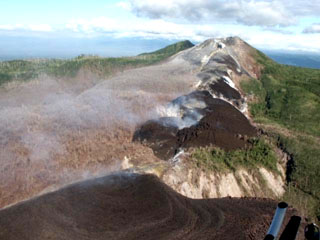Report on Witori (Papua New Guinea) — September 2003
Bulletin of the Global Volcanism Network, vol. 28, no. 9 (September 2003)
Managing Editor: Edward Venzke.
Witori (Papua New Guinea) Minor seismicity and vapor emissions; no lava effusion as of 22 May
Please cite this report as:
Global Volcanism Program, 2003. Report on Witori (Papua New Guinea) (Venzke, E., ed.). Bulletin of the Global Volcanism Network, 28:9. Smithsonian Institution. https://doi.org/10.5479/si.GVP.BGVN200309-252080
Witori
Papua New Guinea
5.5745°S, 150.5161°E; summit elev. 724 m
All times are local (unless otherwise noted)
The eruption at Pago that began in August 2002 continued during early 2003 with lava effusion through at least 28 February and vapor emissions (BGVN 28:03). The Rabaul Volcanological Observatory (RVO) reports that activity at Pago continued, but remained low, from 14 April through 9 October 2003.
The line of vents on the NW slope of Pago continued to release small amounts of thin white vapor over the whole of the period. Occasional weak audible booming noises were heard (eg. on 20 April) and roaring noises were heard on 24 April, 6 May, and 22 May. Very small traces of blue vapor were seen coming from the lower vents on 8 May.
An aerial inspection on 22 May showed that lava effusion from the NW vent had ceased since the February inspection; there were no indications of fresh lava near the vent, no movement of the N and S lobes, and no change in the height of lava against the caldera wall. It also revealed a new fumarolic area to the E.
Monitoring instruments were restored on 19 May. Leveling measurements showed a few centimeters of inflation compared to December 2002. This was considered by RVO to be very significant when compared to previous measurements, but may have been due to nearby roadwork.
Less than 20 volcano-tectonic earthquakes per day were recorded during 25-30 June. A local tectonic earthquake on 9 August seemed to lead to an increase in energy release and event numbers at one seismic station, but it may have been an instrumentation problem. An airborne spectrophotometer revealed only trace amounts of SO2 in early August. Between two and seven volcano-tectonic earthquakes per day were reported in the 26 September-9 October period.
Geological Summary. The active Pago cone has grown within the Witori caldera (5.5 x 7.5 km) on the northern coast of central New Britain contains the active Pago cone. The gently sloping outer caldera flanks consist primarily of dacitic pyroclastic-flow and airfall deposits produced during a series of five major explosive eruptions from about 5,600 to 1,200 years ago, many of which may have been associated with caldera formation. Pago cone may have formed less than 350 years ago; it has grown to a height above the caldera rim, and a series of ten dacitic lava flows from it covers much of the caldera floor. The youngest of these was erupted during 2002-2003 from vents extending from the summit nearly to the NW caldera wall. The Buru caldera cuts the SW flank.
Information Contacts: Ima Itikarai, Rabaul Volcanological Observatory, P.O. Box 386, Rabaul, Papua New Guinea.

